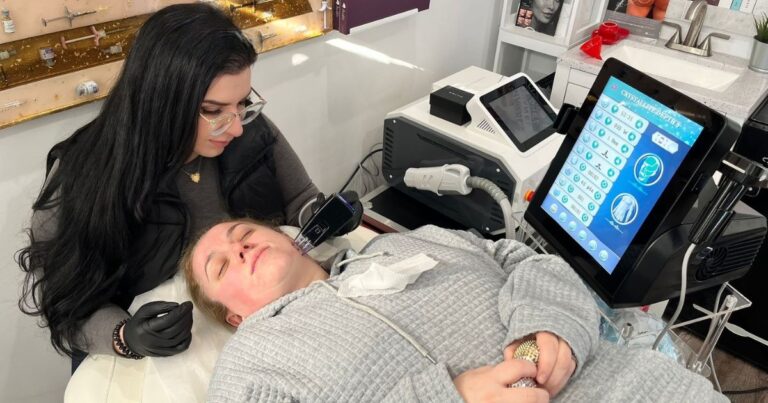Facial fillers are a popular way to refresh your look without surgery. These injectable treatments help smooth lines, restore lost volume, and bring back softer, more youthful features. But with popularity comes a flood of myths, leaving many unsure about what’s true and what’s hype.
You might wonder — will fillers make me look fake? Are they only for older people? Is the procedure painful or risky?
This article dispels the most common myths about facial fillers, allowing you to understand what they truly do and what to expect. By the end, you’ll have a clearer picture to help you decide if fillers are right for you. Let’s break it all down.
Myth #1: Facial Fillers Will Make You Look Fake or Overdone
Many people worry that facial fillers will leave them looking fake or “overdone,” but this fear is often shaped by media images or celebrities who go to extremes. In reality, most people want subtle, natural results — and that’s exactly what skilled injectors aim for.
A good provider focuses on balance, making small, precise adjustments that highlight your natural features, rather than masking them. Fillers aren’t a one-size-fits-all treatment; they’re adjusted to fit your face, your goals, and your comfort level.
When done right, fillers simply help you look like a refreshed version of yourself, not a different person.
Myth #2: Fillers Are Only for Older People

Many assume fillers are just for reversing signs of aging, but that’s not true. While they can smooth wrinkles or restore lost volume in older adults, younger people often use fillers for different reasons, such as adding lip fullness, defining cheekbones, or correcting minor asymmetry.
More people in their 20s and 30s are also choosing small treatments to prevent deeper lines from forming later. It’s not about age; it’s about personal goals and what someone wants to improve or maintain.
Myth #3: Fillers Are Permanent and Can’t Be Adjusted
A lot of people think fillers are permanent, but that’s a big misunderstanding. The most popular fillers, such as those made with hyaluronic acid, typically last between 6 to 18 months. Over time, the body naturally breaks them down, and the treated area gradually returns to its original look.
If someone isn’t happy with their results, hyaluronic acid fillers can be safely dissolved using an enzyme called hyaluronidase. This gives both the injector and the patient flexibility and peace of mind.
Also, touch-ups and small adjustments are normal. They help maintain or improve results, making sure everything stays smooth and balanced.
Myth #4: Fillers Are Painful and Risky
Many people worry that fillers will hurt or come with major risks, but the truth is much simpler. Before treatment, most providers apply a numbing cream, and many fillers already contain lidocaine, a gentle anesthetic. This keeps discomfort low — often compared to a light pinch or pressure.
The procedure is done in-office and usually takes under an hour, with little to no downtime. Most people go back to their normal routine the same day.
As for safety, when fillers are injected by trained professionals, they are considered safe. Common side effects like mild swelling or bruising fade within a few days. Serious complications are rare, especially when you choose an experienced, qualified provider.
Myth #5: You’ll Look Worse When Fillers Wear Off
A common fear is that once fillers fade, your face will sag or look worse than before. This is false. Fillers do not stretch the skin in a permanent way. As they slowly dissolve, the treated area simply returns to how it looked before treatment.
You won’t look older or “deflated” — you’ll just lose the added volume and smoothness the fillers provided. For those who want to keep their results, regular maintenance treatments help keep the look consistent over time.
Myth #6: All Fillers Are the Same
Not all fillers work the same way. Hyaluronic acid fillers, like Juvederm and Restylane, are used to add volume and smooth fine lines. Calcium hydroxylapatite (Radiesse) provides firmer support, often used for deeper wrinkles or jawline definition. Poly-L-lactic acid (Sculptra) works differently by stimulating the body to make more collagen over time.
Each type is made for specific purposes and areas. That’s why it’s so important to have a skilled injector who knows which filler will match your needs. The right choice depends on your face, your goals, and the results you want.
Myth #7: Anyone Can Inject Fillers
Fillers are often seen as a simple beauty treatment, but they are medical procedures that require real expertise. Only trained professionals — like board-certified dermatologists, plastic surgeons, or certified nurse injectors — should perform them.
Choosing an experienced provider matters because they understand facial anatomy, product selection, and proper technique. When fillers are done by unqualified or untrained individuals, the risks of poor results or complications increase sharply.
For the safest and best outcome, always trust your face to someone with the right medical background.
How to Get the Best Results With Facial Fillers

Getting great results with facial fillers isn’t just about the product — it’s about the right approach. With a skilled provider, clear communication, and good aftercare, you can achieve natural, balanced results that fit your face and goals. Here’s what matters most:
- Choose the right provider:
Look for board-certified dermatologists, plastic surgeons, or certified nurse injectors. Check their credentials and review their before-and-after photos. - Communicate your goals:
Be clear about what you want and listen to their advice on what works for your face and features. - Follow care instructions:
Stick to all pre- and post-treatment guidelines, like avoiding alcohol, sun, or heavy exercise, to help healing and improve results. - Start small for natural results:
Less is often more — subtle changes usually look better and feel more like you.
Conclusion
Facial fillers are about more than looks — they’re about confidence and self-care. But to get the best outcome, it’s important to separate fact from myth. Misconceptions can lead to unnecessary fear or poor decisions, so don’t let myths shape your choices.
Instead, educate yourself, ask questions, and work with qualified professionals who understand your goals. When you focus on what’s right for you — not on what you’ve heard — you’re far more likely to walk away with results that feel natural, satisfying, and true to who you are.



